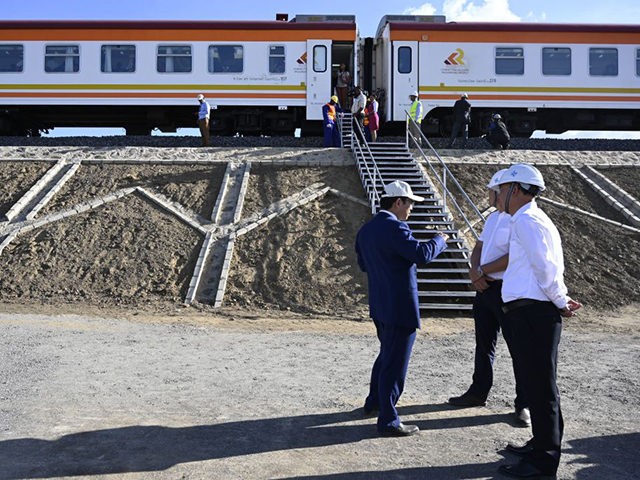China opened the second phase of its $5 billion railroad in Kenya, a major component of the international Belt and Road Initiative, on Thursday.
The new stretch of rail line cost $1.5 billion to complete but had a remarkably low-key debut for such an important project, perhaps reflecting growing criticism that the railroad is doomed and will serve little purpose beyond indenturing Kenya to Chinese loans it can never repay.
The South China Morning Post recalled on Friday that the first phase of the railway, a $3.2 billion line that runs some 300 miles from Mombasa to Nairobi, was opened in 2017 the ceremony was attended by a high-ranking envoy from Chinese dictator Xi Jinping. Phase Two’s opening on Thursday was a far less spectacular affair, attended only by the Chinese ambassador to Kenya.
The big problem with the project, which Kenyan President Uhuru Kenyatta vociferously denies, is that the railroad would be unlikely to turn a profit even if the third and final stage is completed, and there is a good chance it won’t be.
A string of reports was published right before the Phase Two opening that questioned the economic viability of the railroad. China, suddenly short of resources due to its trade war with the United States and smarting from accusations of debt colonialism, is expressing doubts about completing the expensive but indispensable third stage of the project, which would bring the railroad all the way to the Ugandan border.
“We will not be discouraged by baseless claims,” Kenyatta thundered at the opening ceremony, dismissing the skeptical reports. “We know where we want to take the country and we will not allow visionless people to discourage us.”
“The completion of the Nairobi Suswa section of the SGR project is expected to revolutionize the development of the surrounding areas,” he declared.
“China will continue to support Kenya in development projects as it aims to complete the SGR,” promised Chinese ambassador Wu Peng, using a common abbreviation of the formal name of the project, the Standard Gauge Railway. Wu encouraged Chinese companies to invest in the railway and related projects, although he did not actually promise they would do so.
Kenyatta argued it would not be necessary for the SGR to turn a profit if it created enough jobs, attracted enough investment, and facilitated enough commercial activity to compensate for operating losses incurred, but that is exactly what skeptical analysts say will not happen, especially if the line is not completed and linked into a far larger trans-African rail system. Even Kenyatta admitted there would be “challenges along the way” to completing Phase Three of the SRG, although he insisted “that does not mean we will not do it.”
Voice of America estimated, without citing sources, that the SGR is currently generating about $75 million a year in revenue, which would allow Kenya to pay back its Chinese loans in about 60 years. (The most recent report from the Kenyan government pegged railroad income as only about $57 million last year.)
Although the railroad’s comfortable service, scenic route, and inexpensive fares seem popular with Kenyan travelers, the line is primarily intended to haul cargo, and it is the profitability of those operations that most strongly doubted by critics. By most accounts the freight service is not running at a profit, and might never be, even with the nervous Kenyatta administration using cut-rate fees to lure import business. Many potential customers still see road transport as cheaper and more convenient than using the railway. Some estimates put the cost of transporting cargo on the railroad as double the cost of using trucks.
Also, as the South China Morning Post observed in July, many of the best jobs created by the railroad are going to Chinese employees, not Kenyans. The Mombasa railroad terminal is dominated by a statue of a 15th-century Chinese admiral who visited the part of Africa where Kenya would one day be. Kenyans working for the railroad complain of shabby treatment and pervasive Chinese propaganda.
Kenya’s auditor general Edward Ouko in December joined the chorus of critics worried about what will happen if Kenya finds itself unable to repay those massive Chinese loans. One of the primary goals of the SGR project is hauling freight from the port of Mombasa across Kenya and beyond its borders, but according to rumors denied by the Chinese Foreign Ministry, China will take control of the Mombasa port if Kenya defaults on its loan payments.
Even the seemingly successful, if modestly profitable, passenger service on the SGR is beginning to raise some questions.
A few days before President Kenyatta and the Chinese ambassador inaugurated passenger travel on Phase Two of the project, Kenya Railways released schedules from the new Ongata Rongai station and revealed it would only offer connections to four other stations, obliging passengers to make numerous other connections at considerable inconvenience and expense if they wish to travel further. Some of the Kenyans reacting to this on social media derided the service as “unhelpful” and said only a “madman” would use it.
Kenya’s Digital Standard on Friday accused the government of deliberately interfering with truck transportation by issuing orders that make it impossible for drivers to earn a living in an underhanded scheme to make the SGR a more appealing option for cargo. The Digital Standard quoted analysts who said suppressing the trucking industry would wipe out far more jobs than the railway could ever hope to create.

COMMENTS
Please let us know if you're having issues with commenting.